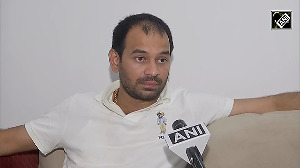The Union Budget has proposed a minimum daily wage of Rs 100 under the National Rural Employment Guarantee Programme and raised the funds by 144 per cent. Rajasthan which already pays Rs 100 as minimum wages, is today experimenting with methods of transparency in the schemes and of ways of dealing with delays. Business Standard reports from the state.
A wall in Vijaypura is an example of what a single positive example can do for a large programme like the National Rrural Employment Guarantee Scheme and for its thousands of beneficiaries who depend on its promise of 100 days of paid work a year.
The wall was put up by sarpanch Kalu Ram a year earlier. It has details of every job card holder in the village, the days they worked, the money they got. Now children in the village can point out the names of their parents on the wall , villagers say.
The news of Vijaypura's great wall travelled to Jaipur and caught the ears of Chief Minister Ashok Gehlot. Last week, he issued orders that such a wall should come up wherever NREGP was implemented.
On June 25, Gehlot also flew down to a large field outside Vijaypura. The occasion was a rozgar guarantee mela, hosted by the sarpanch of Vijaypura. His co hosts were the state administration and the Mazdoor Kisan Shakti Sanghatan, the organisation which earlier spearheaded a grassroots' mobilisation for a comprehensive Right to Information law and then in getting the NREGS fully enforced.
Among other guests were Union rural development minister C P Joshi, the ministry's secretary, Rita Sharma, their state counterparts, and at least 15,000 people from the surrounding villages in Deogarh block of the district.
The stalls at the mela had gram panchayats in Deogarh block exhibit the names of job card holders and the days they worked. Some had details of all the works done in the panchayat, the money sanctioned, the money used, the break-up of money used for wages, materials, etc. All this data would now be painted on the walls of the gram panchayats, MKSS workers said.
The mela is going to be a regular feature of the NREGP now, both in other districts of Rajasthan, as well as outside Rajasthan, Joshi said.
MKSS founder Aruna Roy gives all credit to Kalu Ram. "If not for his persistent effort to keep NREGP the way it is meant to be, he could not have turned Vijaypura into a model village," she says.
Kalu Ram, himself a former MKSS worker, says people will take care of proper implementation of NREGP if there is awareness. And the mela is the best way to create awareness.
He erected the first NREGP info wall in his own hamlet of Narainji ka Bida in Vijaypura last year, when the district got included under NREGP. "In 15 days, all the nine villages in my panchayat had their NREGP details painted on their walls," he says. Now other gram panchayats in the entire state would do this.
He said he wanted every villager to know what he was entitled to and what he had got from the scheme, so that no one would be deprived.
Kalu Ram started off as an MKSS worker by exposing 72 fraudulent land titles in the village and getting a police case lodged against the then sarpanch. He was elected ward member from Narainji ka Bida in 2000, and later as Sarpanch in 2005.
As many as 630 people worked for 100 days in 2008-09 in Vijaypura . A total of 1,296 job cards have been allotted so far, though only 976 people have sought work. The details of all these people can be seen on the panchayat office walls.
Kalu Ram is happy with the mela and the turnout. "I feel this would help other villagers believe that it is possible to implement the scheme with honesty and transparency," he says.







